

GÉRARD DE CORTANZE






Introduction, p. 7
PANHARD ET LEVASSOR TYPE A, p. 8
DE DION-BOUTON TYPE K1, p. 10
HOTCHKISS TYPE E, p. 12
PEUGEOT TYPE 69, p. 14
DELAHAYE TYPE 87, p. 16
HISPANO-SUIZA 32 CV, p. 18
ROLLS-ROYCE 40/50 PHANTOM, p. 22
BENTLEY 3 LITRE SPORT, p. 30
LORRAINE-DIETRICH B3-6, p. 32
PEUGEOT 174 S, p. 34
TRACTION 7A, p. 36
DELAGE D8-120, p. 38
DELAHAYE 135 S, p. 40
HOTCHKISS 686, p. 48
WILLYS JEEP , p. 50
BABY-RHÔNE , p. 52
DODGE WD-20, p. 54
CITROËN 2CV, p. 56
PEUGEOT 203, p. 60
RENAULT 4 CV, p. 62
VOLKSWAGEN TYPE 2 OR “COMBI VOLKSWAGEN”, p. 64
RENAULT FRÉGATE, p. 66
DB HBR4, p. 68
PANHARD DYNA Z, p. 70
MERCEDES-BENZ 300 SL GULLWING COUPÉ , p. 72
RENAULT DAUPHINE, p. 76
LANCIA AURELIA B24 SPIDER, p. 78
SEAT 600 FORMICHETTA, p. 80
RENAULT DAUPHINE GORDINI, p. 82
NISSAN BLUEBIRD, p. 84
CITROËN AMI 6, p. 86
RENÉ BONNET MISSILE, p. 88
FACEL-VEGA FACELLIA, p. 90
RENAULT ALPINE 110, p. 92
FIAT 500 D, p. 94
RENAULT 16, p. 98
CITROËN DS 21, p. 37
OPEL COMMODORE A, p. 104
PEUGEOT 204 COUPÉ, p. 106
LOLA T70, p. 108
FORD MUSTANG SHELBY GT 500, p. 110
NISSAN FAIRLADY Z (S30), p. 112
CITROËN SM MASERATI, p. 114
FIAT X 1/9, p. 116
RENAULT 5, p. 118
MATRA SIMCA MS 670, p. 120
VOLKSWAGEN GOLF, p. 122
LANCIA DELTA S4, p. 124
FERRARI F40, p. 126
JEEP WRANGLER, p. 128
MAZDA MX-5, p. 130
CITROËN XM, p. 132
NISSAN FAIRLADY Z32, p. 134
PEUGEOT 905, p. 136
RENAULT CLIO, p. 138
LAMBORGHINI DIABLO, p. 140
MAZDA 787 B, p. 144
DODGE VIPER, p. 146
RENAULT TWINGO, p. 148
BMW SERIES 7 E38, p. 150
FERRARI F355, p. 152
CITROËN ZX FUKANG, p. 154
SUZUKI SANTANA, p. 156
ALFA ROMEO 156, p. 158
VOLKSWAGEN NEW BEETLE, p. 160
SMART FORTWO, p. 162
ASTON MARTIN DB7, p. 164
SAAB 9-3, p. 166
JAGUAR XJ8, p. 168
PORSCHE CAYENNE, p. 170
MASERATI QUATTROPORTE M139, p. 172
LAMBORGHINI GALLARDO, p. 174
VOLKSWAGEN TOURAN, p. 176
BUGATTI VEYRON 16.4, p. 178
AUDI R8, p. 182
NISSAN QASHQAI, p. 184
NISSAN GT-R, p. 186
MERCEDES-BENZ SLS-AMG, p. 190
AUSTIN MINI, p. 192
VOLKSWAGEN TOUAREG, p. 194
PORSCHE 911 TYPE 997, p. 196
LAMBORGHINI AVENTADOR LP700, p. 198
MERCEDES S-CLASS, p. 204
RANGE ROVER L405, p. 206
CHEVROLET CORVETTE C6, p. 208
INFINITI Q50, p. 210
NISSAN E-NV200 EVALIA, p. 212
RENAULT ESPACE IV, p. 214
VOLKSWAGEN PASSAT B8, p. 216
MERCEDES E-CLASS TYPE 213, p. 218
AUDI A8 D5, p. 220
CADILLAC CT6, p. 222
CHEVROLET SILVERADO 1500, p. 224
HONDA JAZZ, p. 226
CITROËN AMI, p. 228
LAND ROVER DEFENDER 110 D240, p. 230
MERCEDES-BENZ S-CLASS TYPE 223, p. 232
WAYMO ROBOTAXI, p. 234
BMW I20 M60, p. 236
MERCEDES EQS, p. 238
Symbolized by the figure on the car’s radiator of a flying woman at the height of the ecstasy imparted by speed, Rolls Royce was described by a journalist writing in The Times as “the best car in the world”, as early as 1908. This was a 15-hp model with a maximum speed of 63 kph, equipped with artillery wheels, a suspension on semi-elliptical leaf springs, a three-speed gearbox and a 6-valve engine of 3.1 liters or 3,089 cc. It was followed by the Silver Ghost and Silver Cloud series, and another 40/50 Phantom, known as the “aluminum sculpture” because its bodywork and chassis were made of this light, malleable metal. The latter, a luxury four-door model with a 7,668-cc engine, was produced from 1925 to 1931. Altogether, 3,512 of them were made. They were all equipped with windshield wipers and with sparking plugs by Marchal, whose logo, a cat’s face with phosphorescent eyes, announced: “I only lend my eyes to Marchal.”
But to return to the Silver Ghost, whose name characterized its silence rather than its phantasmagoric image. It was this model, produced in all its variations from 1906 to 1925, that secured

the prestige of Rolls-Royce. Its owners felt that they belonged to a cult numbering no less than 6,173 members. Each member owned the variant that suited him best. For example, the Silver Ghost Barker, which was said to be so quiet that the loudest noise passengers would hear was the ticking of the dashboard clock… Or the Silver Ghost Barker Landaulet, one specimen of which ended up at the bottom of the sea when a German submarine sank
the ship carrying its owner, who never travelled without his car, a certain Alfred Gwynne Vanderbilt! As for the Silver Ghost Shapiro-Schebera Skiff, it boasted wooden coachwork.




Produced in France from 1956 to 1967, the Renault Dauphine was the biggest-selling car in the country between 1957 and 1961. It owed this welldeserved success to several factors: its affordable price, its lightness, its more than reasonable fuel consumption (6.5 liters per 100 kilometers), and its 32-liter fuel tank, which gave it a range of 400 kilometers at constant speed. In addition, it had soft, comfortable seats, a passenger compartment that was bigger than it looked and, of course, the technical features which made it, even in its basic version, a very reliable vehicle: load-bearing monocoque body, independent suspension all round, 845-cc four-cylinder engine, hydraulically operated drum brakes. A few optional extras were available, such as the sunroof or the Ferlec automatic clutch, which it did not hesitate to mention conspicuously on the rear engine cover: “Ferlec automatic clutch.”
As the years went by, the models evolved. The Sofica heating unit using hot water and an electric fan replaced the model with blown air and flaps, new “Aerostable” front suspension was introduced, the side indicator lights made way for round
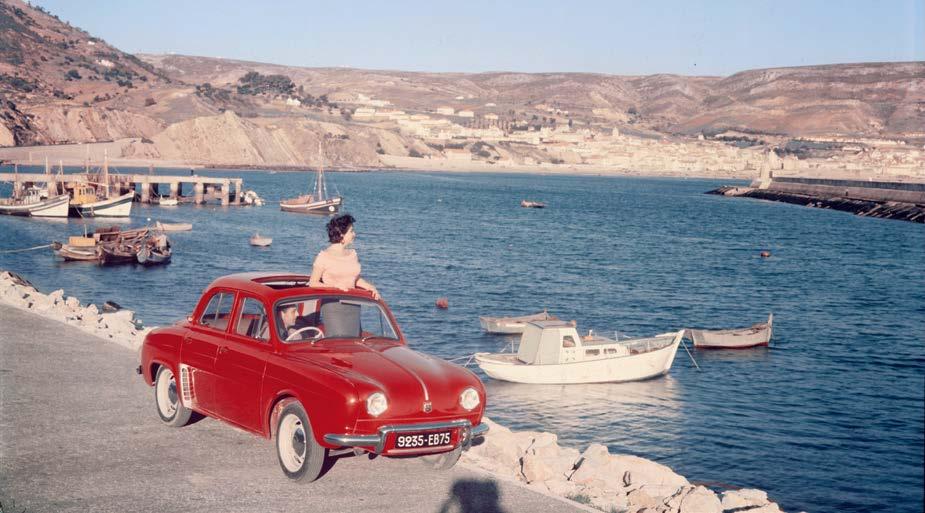
flashing indicators under the headlights and the engine was pushed up to 28 DIN horsepower to achieve 115 kph. And above all, the Dauphine established itself abroad: in the United States, Spain, Italy and Argentina. It was even used as the basis for an experiment in the field of electric
cars, in consultation with Linus Pauling: the Henney Kilowatt electric car. As the American advertisement proclaimed: “With the Dauphine’s ‘Joie de vivre’, driving is fun again.”
Renault Dauphine, 1956 model, with sun roof.

Founded in 1899, Fiat (Fabbrica Italiana Automobili Torino) played a decisive role in the early years of motor car racing. Fiat won everything, except the hill-climbing events. Those were the great days of the red cars, Italy’s color. The climax came on April 12, 1924 on the long, straight stretch of the RN20 trunk road, at Arpajon.
The “Mefistofele,” a huge, 120-hp four-cylinder had been fitted by its owner with a 21.7-liter, six-cylinder airship engine. His aim: to beat the world speed record. He succeeded: 234.85 kph.
What followed is another story. Fiat, proud of its victories, added a crown of laurel leaves to its logo. Gradually withdrawing from motor racing, it soon won fame by bringing Italy the popular car the country had been waiting for: the Nuova 500, seen by some as a toy escaped from a merry-go-round or a comic strip, described by others as the “piccola grande auto,” but which, to many, will always be “the yogurt pot,” emblem of the sixties. These cars were made from 1957 to 1975, and more than 4 million would be produced. Small, adaptable and indestructible, they boasted
a Ferodo clutch, guarantor of extended life, better resistance to friction and more efficient transmission of engine power. And in addition, at a time when new safety regulations were forcing manufacturers to innovate, with separate sidelights and direction indicators, indicator repeaters on the wings, modified front and rear lights, etc., Valeo supplied the steering-column controls and switches. Anyone who loves Italy and the Fiat 500 should watch the advertising film entitled “Cinefiat presents the New 500.” Bellissima, this little city car!
Fiat soon won fame by bringing Italy the popular car the country had been waiting for.


The first-generation Volkswagen Golf, the Golf 1, was a compact sedan which had to bear the burden of a separation from the old Beetle. The artistic design was entrusted to Giorgietto Giugiaro. The founder of Italdesign, he had already given the world the Alfa Romeo Giulia GT, the Fiat Dino, the Lotus Esprit and, for Volkswagen, the Passat. His watchword was: the cube. So the little Golf 1 hatchback would display edges rather than curves. Dynamic and flexible, at its launch in 1974 it already offered a range of accessories and options which would lead to its success: automatic transmission, sunroof, automatic windows, diesel version, then turbodiesel, Valeo heating and air conditioning units, etc. Its sports version, the GTI, in direct competition with the Renault 5 GT Turbo and the Peugeot 205 GTI, wrought havoc. Its greatest asset was its 1.6-liter, 110-hp fuel injection engine.
The story of Valeo and the Golf did not end with the 1970s. In 2007, when optimization of energy consumption was taking priority over simple performance, VW launched the VW Golf 1.4 TSI, the first vehicle equipped with a water-cooled charge air unit by Valeo. Five years later, it was the
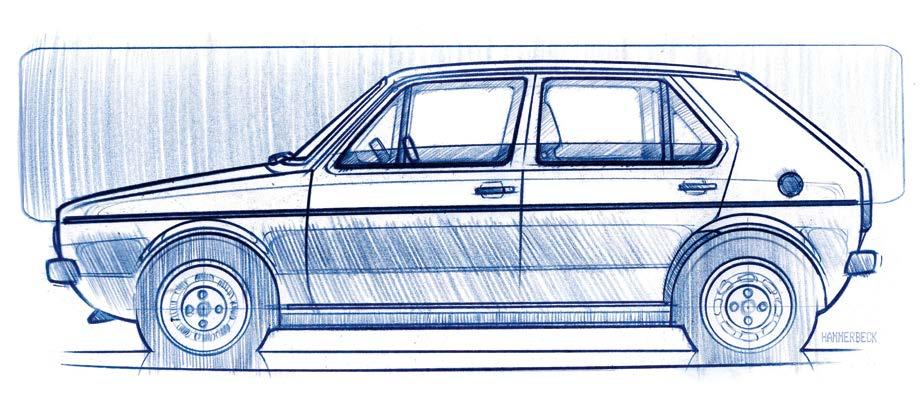
“The Golf 1 was a compact sedan which had to bear the burden of a separation from the old Beetle.”
Golf 7’s turn to be equipped with an “air intake module” which enhanced the energy efficiency of supercharged engines while at the same time contributing to the reduction of polluting emissions. It remains probably the car most characteristic of the 1970s.
Volkswagen Golf, 1974 (above, a drawing-office sketch).


In their illustrated book, Les Plus Belles Voitures de tous les temps (the most beautiful motor cars of all time), Ron Kimball and Matt Delorenzo include 4 Lamborghinis. The 2008 Reventon: presented at the Frankfurt Motor Show in 2006, powered by a 6.5-litre V12 developing 650 bhp, it could reach 340 kph and sold at 1 million euros before tax. The Murciélago Roadster 2006, presented in 2001: elytron doors, sober lines, powered by a 580 or 640-hp engine, giving a top speed of 330 or 340 kph respectively. The third is the 1985 Countach. Designed by Marcello Gandini, this car alone was enough to justify the adjective “eccentric” often applied to Italian cars. Mid-engined (in rear position here), elytron doors, an abundance of air intakes and scoops, and rear vision so poor that when the driver wanted to park, he had to open his door and lean out to avoid any possible obstacles. In Piedmontese, “Countach” is an exclamation expressing admiration. The fourth and last one is the Diablo VT 1998. Also designed by Marcello Gandini, but this time with financial support from Chrysler, it was presented at the Chicago Motor Show in 1990. Let us pause to consider this exceptional car. Its name alone is quite

a story. Following the tradition established by the car’s creator, Ferruccio Lamborghini, Diablo was the name of a bull bred on the Duke of Veragua’s cattle farm. On July 11, 1869, this bull fought an epic battle against the famous torero José Lara Jiménez in the arena of Madrid. Technical details of the Lamborghini Diablo: 5.7-litre V12 engine developing 492 hp, it could exceed 325 kph with ease. Like the very first Diablos, its standard
equipment was reduced to the barest minimum – but it was equipped with a 272-mm clutch set by Valeo.


Eager to capture part of the huge Chinese market, Citroën planned to offer motorists of the Middle Kingdom a car that would be neither too big nor too small, designed to attract a wide variety of customers. Chinese law required a partnership with a local manufacturer, so the firm sporting the double chevron chose the Dongfeng company. Several years of negotiations culminated in the creation of the Dongfeng-Citroën company. Its first product, derived from the ZX, would be marketed as the Fukang, which means “health and prosperity.”
The ZX Fukang, manufactured from 1991, was a transverse-engined front-wheel drive car available in a four or five-door version, burning petrol or diesel. Although its equipment was spartan and it did not have power-assisted steering, it could boast one major asset: remarkable roadholding and extremely comfortable suspension. Its headlights were made in the Hubei Valeo Auto Lighting Company’s factory, situated in Hubei province, the nerve centee of the Chinese motor industry. In December 1995, the production of the millionth Citroën ZX Fukang was celebrated with great pomp. A double line of uniformed guards was posted at

the entrance to the assembly plant of the Wuhan factory. Young women wearing red cheongsams handed out artificial flowers to wear as buttonholes. The air was full of shrill music. Jaques Calvet, CEO of PSA was present, together with Yves Galland, minister for foreign trade, and a galaxy of Chinese dignitaries… Citroën ZX Fukang (right, manufacturer’s advertising).
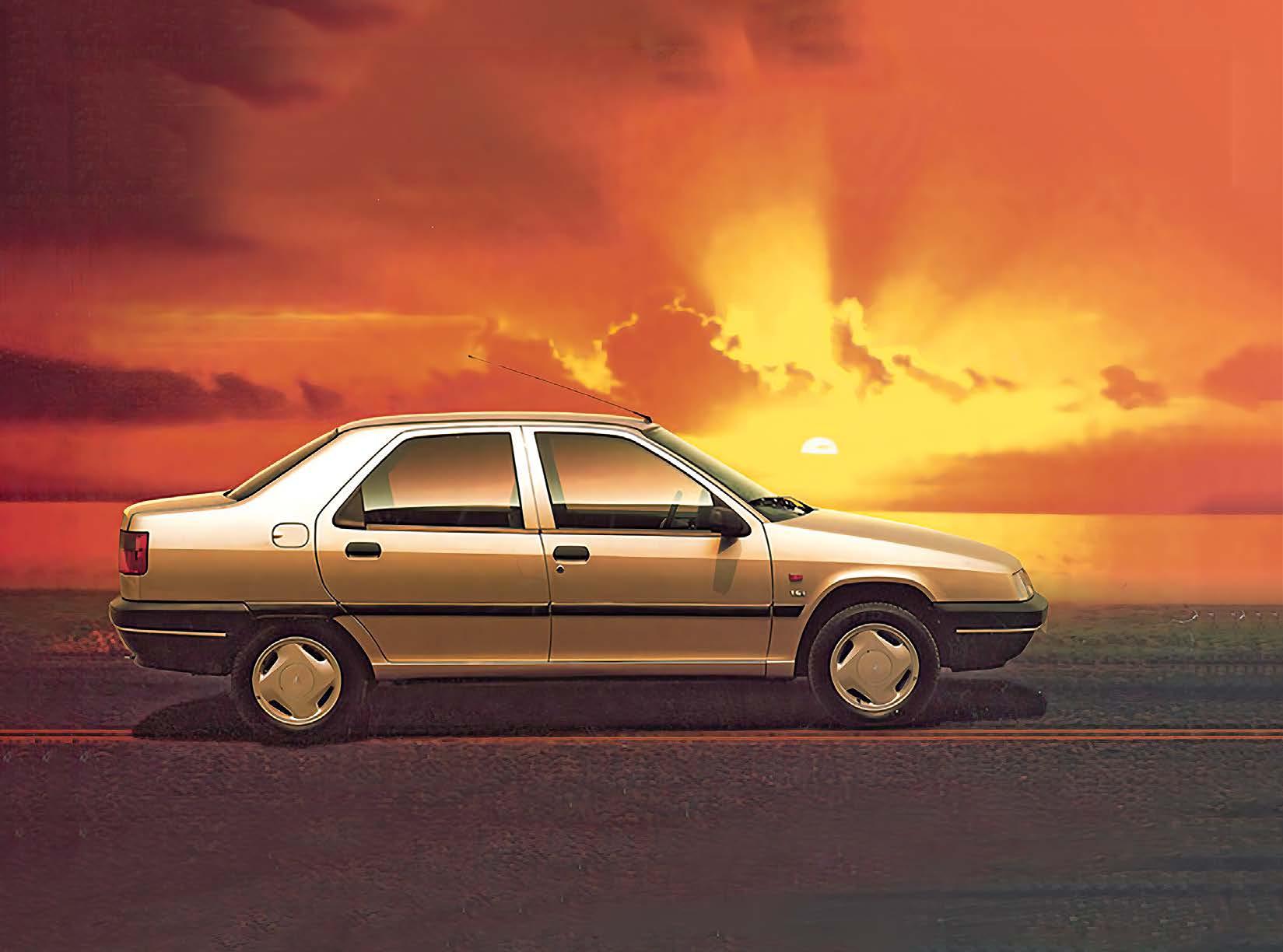
The history of the German car manufacturing group founded in 1937 in, and based at, Wolfsburg, in Lower Saxony, may be less well known, but everyone is acquainted with the story of the birth of the Kdf-wagen, the most famous model to leave its workshops, when Adolf Hitler asked Ferdinand Porsche to build a car costing less than 1,000 Reichsmarks, affordable for all, based on mass production and consumption. After testing by two hundred young SS members, who took turns driving it, foot to the floor, day and night, over 75,000 kilometers, the Beetle began its extraordinary career. Sixty-five years later, the last one rolled off the assembly lines in Mexico: it was the 30 millionth!
When the neo-retro fashion wave swept across the world, Volkswagen jumped onto the bandwagon, and in 1998 launched the very trendy New Beetle: a front-wheel drive car (the beetle was rear-wheel drive) weighing 1,200 kilos (the beetle only weighed 800). The nostalgic were charmed; purchasers rather less so: spartan comfort, seats too rigid, absurd passenger space and boot, overpriced. Air conditioning remained a strong point. Supplied by

Valeo, it worked like a domestic refrigerator, that is, with a compressor and refrigerating gas which, according to its phase – liquid or gas – produced cold.
After several models intended to improve the New Beetle –the RS1, RS2, Isotope Green, New Beetle
Phase II – a third-generation Beetle was launched at the Shanghai Motor Show in 2011. But success remained elusive. The Beetle was a tough, multipurpose vehicle. The New Beetle was perceived
as too rounded, too colorful, too pastel-shaded. Rightly or wrongly, some reproached Volkswagen with trying to turn the “people’s car” into a “women’s car.” This altered perception proved fatal to it.

It is said, with justice, that the Bugatti Veyron 16.4 was the car with the most “mosts.” It is undeniable that the production specification set a challenge that many people thought unattainable: over 1,000 bhp, maximum speed over 400 kph, acceleration from 0–100 kph in less than three seconds… The most innovative sectors of industry took part in the project, the most sophisticated materials, never previously used in motor manufacture, were called into play, and the developers even went to the length of knocking on doors in the very exclusive circles of aeronautical and space research.
The result lived up to all expectations. Here was a superb, elegant sports car, reliable and ahead of its time. Its outstanding features: an exceptional engine-gearbox unit, permanent all-wheel drive with an electronically controlled sequential gearbox with a DSG-type double clutch, special tires (a rubber blend produced by the PAX procedure), a carbon-fiber chassis in combination with aluminum body elements, oversize brakes developed by the British company AP Racing, and more. The equipment was crowned with a Valeo Intelligent
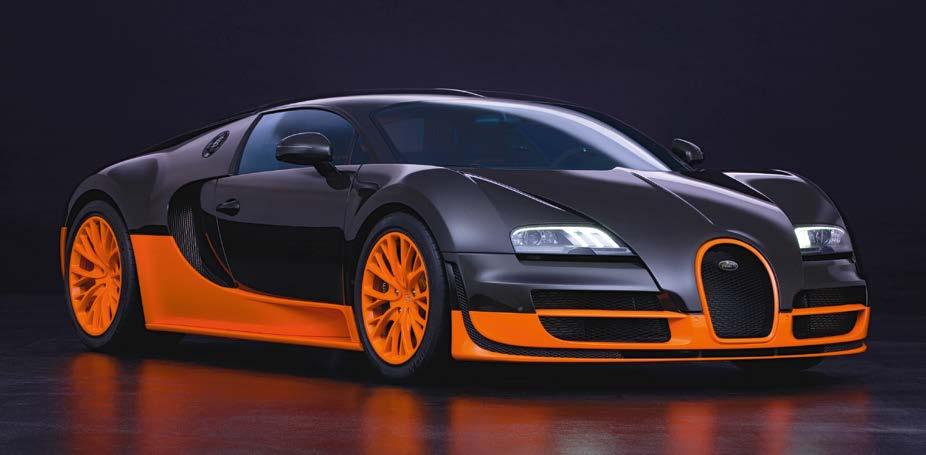
Parking Assist System. It should be noted, however, that although the speedometer might display 413 kph, the fuel consumption figures (combined) could reach 24.1 liters per 100 kilometers. So that Gordon Murray, the engineer who had worked on the Maclaren F1, remarked that this Bugatti, with its 1,000 bhp and all-wheel drive, was “the most pointless exercise on the planet.”
The Bugatti website says it all – in just a few words: “The Veyron 16.4 is sold out.” Production period: 2005 to 2015. Number produced: 450. The most recent Grand Sport Vitesse is currently priced at 2,000,000 euros.
16.4, 2005.


The Honda Jazz is just over 20 years old. In the course of its long career, it has undergone numerous improvements. The first being a degree of uncertainty about its name. Initially, Honda had considered calling it the “Fitta,” rapidly abbreviated to “Fit,” which was held to be shorter, more dynamic and very suitable for this roomy, multipurpose city car. But linguistics and motor cars do not always make good bedfellows. The name “Fit” was swiftly abandoned when it transpired that, in several Nordic languages, the word means “vulva!”
With that matter settled, the little car set out from Japan to conquer the world. A wide range of versions were on offer: van, station wagon, crossover, Crosstar; gasoline – standard or hybrid – etc.
At this point, the question of self-driving vehicles arose, with the invention of LiDAR (Light Detection and Ranging) sensors, an intelligent ranging device. Valeo’s secondgeneration laser LiDAR went into production in 2021. The first vehicle in the world to be approved for Level 3 automation on the SAE

scale was a Honda using Valeo LiDAR scanners in combination with two front cameras and a Valeo computer.
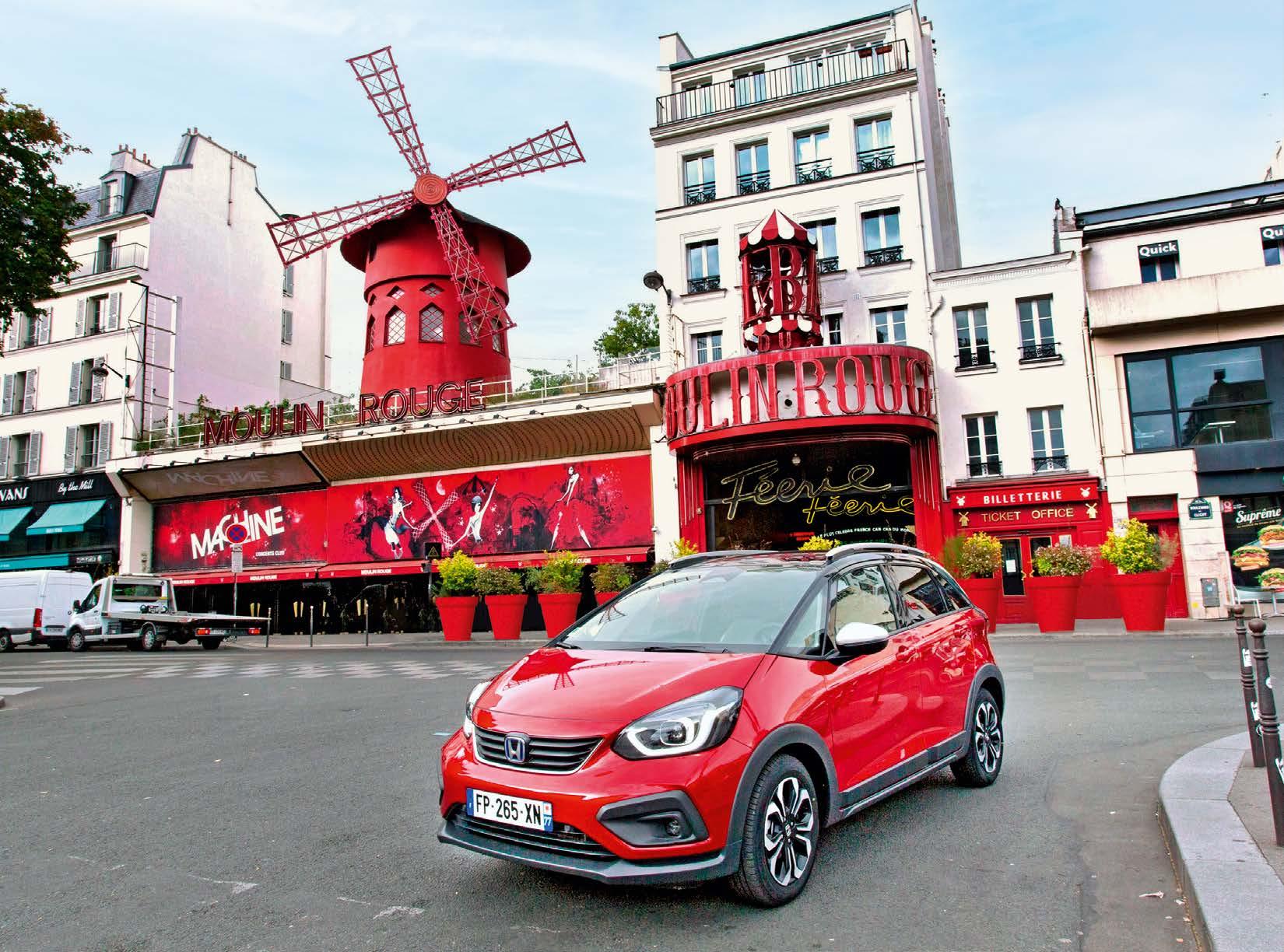

The Mercedes S-Class celebrates its 30th anniversary. Sedan, limousine, coupé or convertible, it is the marque’s star model and a worthy successor to the famous Sonderklasse: the “Special Class.”
Unveiled in September 2021, the last S-Class of its generation is offered with a choice of four powertrains: diesel, gasoline, mild hybrid (48V) or plug-in hybrid with an electric range of over 100 kilometers.
With a selling price from 100,000 to 113,000 euros, there are not enough superlatives to do it justice. Back in 1993, the S-Class was the first car in the world to be fitted with airbags as standard, ESP stability control and parking assistance, and it has not ceased to incorporate the latest technological advances while retaining what has always made its reputation: reliability, power and safety. Its competitors are the Rolls-Royce Ghost and the Bentley Flying Spur or Mulsanne; the latter being named in honor of Bentley’s six victories in the Le Mans 24 Hours between 1924 and 1930, while the winner in 2003 was a Bentley Speed 8. Proof, if any was needed, of the ambition of the Mercedes S-Class to remain at the cutting edge

of innovation: the latest model to roll off the production line is the second Level 3 certified car (on the SAE scale) to be equipped with Valeo’s Ultrasonic Door Protection, which shows the driver or passenger intending to open their door whether
there is a cyclist or other obstacle preventing this action.
Mercedes-Benz S-Class Type 223.


How to tell the story of motoring through a hundred cars was the challenge taken up in this book, in which anecdote and technology complement and support each other, taking the reader on a journey of discovery among iconic classics: from the Panhard et Levassor type A to the Rolls-Royce Phantom, from the Citroën Traction Avant to the Renault Dauphine, from the Ford Mustang Shelby to the Porsche 911!
A hundred years of innovation, inventiveness and triumphs are condensed in this book, which reads as easily as a novel, and is illustrated with a rich and rare iconography.

